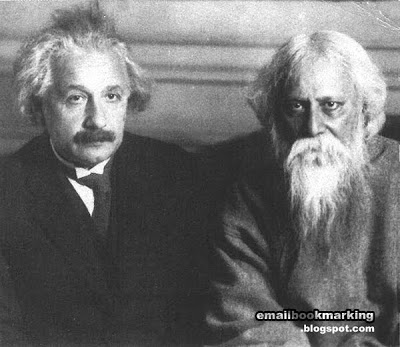Pardeep
๑۩۩๑┼●ℛŐŶ
Dug up from the files, half torn or lost and half almost unreadable, here is a very very rare pic of the two great masters of the human history, Albert Einstein and Rabindranath Tagore, Taken back in the year 1930 at Dhaka, where Einstein came to see Mr. Tagore. Nothing more to say, than just having a look at the pic might make your day.

Rabindranath Tagore (Bengali: রবীন্দ্রনাথ ঠাকুর)α[›]β[›](7 May 1861 – 7 August 1941), sobriquet Gurudev, was a Bengali polymath. As a poet, novelist, musician, and playwright, he reshaped Bengali literature and music in the late 19th and early 20th centuries. As author of Gitanjali and its "profoundly sensitive, fresh and beautiful verse", he became Asia's first Nobel laureate by winning the 1913 Nobel Prize in Literature.
A Pirali Brahmin from Calcutta, Tagore wrote poems at age eight. At age sixteen, he published his first substantial poetry under the pseudonym Bhanushingho ("Sun Lion") and wrote his first short stories and dramas in 1877. Tagore denounced the British Raj and supported the Indian Independence Movement. His efforts endure in his vast canon and in the institution he founded, Visva-Bharati University.
Tagore modernised Bengali art by rejecting the strictures of rigid classical Indian forms. His novels, short stories, songs, dance-dramas, and essays ranged over political and personal topics alike. Gitanjali (Song Offerings), Gora (Fair-Faced), and Ghare-Baire (The Home and the World) are among his best-known works, and his verse, short stories, and novels were acclaimed for their lyricism, colloquialism, meditative naturalism, and philosophical contemplation. Two Tagore songs are the national anthems of Bangladesh and India: Amar Shonar Bangla and Jana Gana Mana.
Albert Einstein (pronounced /ˈælbərt ˈaɪnstaɪn/; German: [ˈalbɐt ˈaɪ̯nʃtaɪ̯n] 14 March 1879–18 April 1955) was a theoretical physicist. His many contributions to physics include the special and general theories of relativity, the founding of relativistic cosmology, the first post-Newtonian expansion, explaining the perihelion advance of Mercury, prediction of the deflection of light by gravity and gravitational lensing, the first fluctuation dissipation theorem which explained the Brownian movement of molecules, the photon theory and wave-particle duality, the quantum theory of atomic motion in solids, the zero-point energy concept, the semiclassical version of the Schrödinger equation, and the quantum theory of a monatomic gas which predicted Bose-Einstein condensation.
Einstein is best known for his theories of special relativity and general relativity. He received the 1921 Nobel Prize in Physics “for his services to Theoretical Physics, and especially for his discovery of the law of the photoelectric effect”.
Einstein published more than 300 scientific and over 150 non-scientific works.[3] He is often regarded as the father of modern physics.

Rabindranath Tagore (Bengali: রবীন্দ্রনাথ ঠাকুর)α[›]β[›](7 May 1861 – 7 August 1941), sobriquet Gurudev, was a Bengali polymath. As a poet, novelist, musician, and playwright, he reshaped Bengali literature and music in the late 19th and early 20th centuries. As author of Gitanjali and its "profoundly sensitive, fresh and beautiful verse", he became Asia's first Nobel laureate by winning the 1913 Nobel Prize in Literature.
A Pirali Brahmin from Calcutta, Tagore wrote poems at age eight. At age sixteen, he published his first substantial poetry under the pseudonym Bhanushingho ("Sun Lion") and wrote his first short stories and dramas in 1877. Tagore denounced the British Raj and supported the Indian Independence Movement. His efforts endure in his vast canon and in the institution he founded, Visva-Bharati University.
Tagore modernised Bengali art by rejecting the strictures of rigid classical Indian forms. His novels, short stories, songs, dance-dramas, and essays ranged over political and personal topics alike. Gitanjali (Song Offerings), Gora (Fair-Faced), and Ghare-Baire (The Home and the World) are among his best-known works, and his verse, short stories, and novels were acclaimed for their lyricism, colloquialism, meditative naturalism, and philosophical contemplation. Two Tagore songs are the national anthems of Bangladesh and India: Amar Shonar Bangla and Jana Gana Mana.
Albert Einstein (pronounced /ˈælbərt ˈaɪnstaɪn/; German: [ˈalbɐt ˈaɪ̯nʃtaɪ̯n] 14 March 1879–18 April 1955) was a theoretical physicist. His many contributions to physics include the special and general theories of relativity, the founding of relativistic cosmology, the first post-Newtonian expansion, explaining the perihelion advance of Mercury, prediction of the deflection of light by gravity and gravitational lensing, the first fluctuation dissipation theorem which explained the Brownian movement of molecules, the photon theory and wave-particle duality, the quantum theory of atomic motion in solids, the zero-point energy concept, the semiclassical version of the Schrödinger equation, and the quantum theory of a monatomic gas which predicted Bose-Einstein condensation.
Einstein is best known for his theories of special relativity and general relativity. He received the 1921 Nobel Prize in Physics “for his services to Theoretical Physics, and especially for his discovery of the law of the photoelectric effect”.
Einstein published more than 300 scientific and over 150 non-scientific works.[3] He is often regarded as the father of modern physics.
